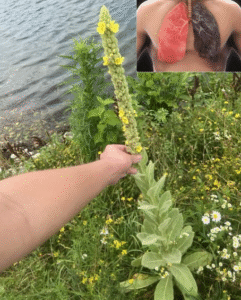Nature’s Lung Cleanser? Viral Image of Mullein Plant Sparks Herbal Health Buzz
An image circulating online is turning heads—and clearing lungs, at least according to herbal enthusiasts. The viral post shows a hand grasping a tall, flowering plant along a riverside, with a striking inset of two lungs—one healthy and pink, the other blackened and diseased. The plant in question? Mullein, a centuries-old medicinal herb hailed in natural medicine circles for its powerful respiratory benefits.
Known scientifically as Verbascum thapsus, mullein is a biennial plant recognized by its tall flowering stalk, soft, velvety leaves, and bright yellow blooms. Often found along roadsides, meadows, and near bodies of water, this hardy plant has long been used in folk remedies to treat coughs, congestion, bronchitis, and other lung-related ailments. Now, thanks to social media, it’s getting a new wave of attention as a “natural lung cleanser.”
The inset image of the lungs, visually contrasting health and disease, serves as a dramatic reminder of what clean air and care for the body might mean—and the role plants like mullein may play in holistic healing. “This plant is a game-changer,” one viral post reads. “Dry the leaves, make a tea, and feel your lungs open up. Nature really has the cure.”
While some may roll their eyes at the natural remedy craze, there’s actually some science to back the buzz. Mullein has anti-inflammatory, expectorant, and antimicrobial properties. Herbalists commonly use its dried leaves or flowers to create teas, tinctures, or even herbal smoking blends (yes, ironically, a lung-supportive plant that people sometimes smoke). The idea is that it soothes irritated lungs, helps expel mucus, and promotes easier breathing.
For people with asthma, colds, or respiratory infections, mullein tea has long been a go-to home remedy. Its soothing qualities come from compounds like saponins and mucilage, which can help coat and calm irritated airways. While it’s not a replacement for modern medical treatments, many users report noticeable relief when using it regularly during respiratory illness or seasonal allergies.
However, experts do caution that not all claims should be taken at face value. Just because a plant is natural doesn’t mean it’s automatically safe for everyone. People with plant allergies or those on certain medications should check with a healthcare provider before trying mullein, especially in concentrated extract form.
Still, the broader message behind the image resonates: nature is powerful, and often overlooked as a source of healing. The juxtaposition of lush green growth and damaged lungs sends a clear signal—perhaps it’s time to look more closely at what the Earth offers in terms of health and balance.
Whether you’re a committed herbalist, a curious newcomer to natural health, or simply someone inspired by beautiful and bold imagery, mullein might just be a plant worth knowing. As interest grows, it’s likely this once-overlooked weed will continue earning its place in gardens, herbal pantries, and Instagram feeds alike.
